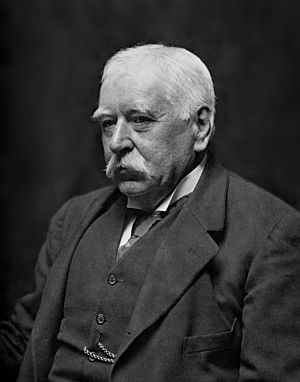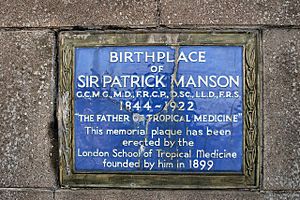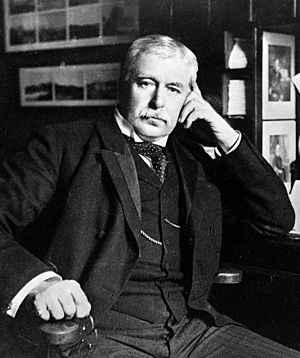Patrick Manson facts for kids
Quick facts for kids
Sir Patrick Manson
|
|
|---|---|
 |
|
| Born | 3 October 1844 Oldmeldrum, Aberdeenshire, Scotland
|
| Died | 9 April 1922 (aged 77) London, England
|
| Resting place | Allenvale cemetery, Aberdeen |
| Alma mater | University of Aberdeen |
| Known for | Founding the discipline of tropical medicine |
| Awards | Cameron Prize for Therapeutics of the University of Edinburgh (1901) |
| Scientific career | |
| Fields | Medicine Parasitology |
| Institutions | Hong Kong College of Medicine for Chinese Albert Dock Seamen's Hospital London School of Hygiene & Tropical Medicine |
Sir Patrick Manson (born October 3, 1844 – died April 9, 1922) was a Scottish doctor. He made very important discoveries about tiny living things called parasites. He is also known as the "Father of Tropical Medicine." This is because he helped create the study of diseases common in hot, tropical parts of the world.
Manson studied at the University of Aberdeen. He earned degrees in surgery and medicine. His work took him to places like mainland China, Hong Kong, Taiwan, and London. He famously found out that a disease called filariasis (which causes elephantiasis) is spread by mosquitoes. This discovery was a huge step for understanding how many tropical diseases spread. He later became the first President of the Royal Society of Tropical Medicine and Hygiene. He also started two important medical schools: the Hong Kong College of Medicine for Chinese and the London School of Hygiene & Tropical Medicine.
Contents
Early Life and School
Patrick Manson was born in Oldmeldrum, Scotland. His father managed a bank and owned land. His mother was a distant relative of the famous explorer David Livingstone. Patrick was the second of seven children. As a child, he loved nature, fishing, and building things. He had an amazing memory, even as a young boy.
In 1857, his family moved to Aberdeen. He went to Gymnasium School and then West End Academy. In 1859, he started training with a company that made iron. However, he became sick with a type of tuberculosis that affected his spine. This forced him to rest.
In 1860, he began studying medicine at the University of Aberdeen. He finished his medical course in 1865. He was too young to graduate, so he spent time visiting hospitals in London. In October 1865, he officially graduated. He then worked for seven months at a hospital for people with mental illnesses in Durham. He studied many patients for his medical paper. In 1866, he received his advanced medical degrees.
Working in China
Patrick Manson's older brother, David, was a doctor in Shanghai. This inspired Patrick to become a medical officer in Formosa (now Taiwan). In 1866, Manson went to Formosa to work for the Chinese Customs Service. This was the start of his long career studying tropical diseases.
His daily job was to check ships at the port and keep weather records. He also treated Chinese patients at a local missionary hospital. Here, he saw many different tropical diseases. He learned a lot on his own, using his medical skills and careful notes. He got along well with the local Chinese people and learned to speak Mandarin.
After five years, he had to leave Formosa because of political problems between China and Japan. He moved to Amoy, on the Chinese coast. He worked there for 13 more years, helping Chinese patients at another hospital. His brother David joined him for two years.
Discovering How Diseases Spread
Manson spent his early years studying filaria. These are tiny worms that cause a disease called elephantiasis. This disease makes body parts swell up very large. Manson looked for these worms in the blood of his patients.
He noticed something interesting: the worms were only in the blood at night. They were gone during the day. He did experiments with his gardener, Hin Lo, who had filaria. Manson let mosquitoes feed on Hin Lo's blood while he slept. Then, Manson carefully looked at the mosquitoes under a microscope. He found that the worms were still alive inside the mosquitoes.
Manson realized that the filaria worms only grew a little bit in human blood. He thought that mosquitoes must play a role in the worm's life cycle. In 1877, he made a huge medical breakthrough. He showed that the mosquito (a type called Culex fatigans) was the intermediate host for the filaria parasite. This meant the mosquito carried the parasite from one person to another. His findings were published in 1878.
The Mosquito-Malaria Theory
Manson's discovery led to a new idea: the mosquito-malaria theory. This idea suggested that malaria was also spread by mosquitoes. In 1894, he wrote an article saying that if mosquitoes carried filaria, they might also carry the malaria germ. He encouraged doctors in places like India to test his idea.
Sir Ronald Ross met Manson in London. Ross then went to India to prove Manson's theory. Their letters back and forth show how much they worked together. In 1898, Ross finally proved the theory. He showed the full life cycle of the malaria parasite inside female mosquitoes. Ross won the Nobel Prize for Physiology or Medicine in 1902 for this discovery.
Manson also found a new type of parasite called Schistosoma mansoni. This parasite causes a disease known as Bilharzia. In 1882, he also discovered sparganosis, another parasitic infection.
Working in Hong Kong
From 1883 to 1889, Manson lived and worked in Hong Kong. He was the first person to bring cows from Scotland to Hong Kong. He started a dairy farm there in 1885, which became the company Dairy Farm.
His most important work in Hong Kong was in medical education. He founded the Hong Kong College of Medicine for Chinese. One of his first students was Sun Yat-sen. In 1896, Manson used his connections to help free Sun Yat-sen. Sun had been kidnapped in London by Chinese officials. Sun Yat-sen later became the first President of the Republic of China. In 1911, the Hong Kong College of Medicine became the University of Hong Kong.
Returning to London
After 23 years in Southeast Asia, Manson had earned a lot of money from his medical work. He moved back to London in 1889. In 1890, he became a member of the Royal College of Physicians. He became a doctor at the Seamen's Hospital Society in 1892. He also taught about tropical diseases at St George's Hospital.
In 1897, he became the Chief Medical Officer for the Colonial Office. He used his influence to push for a special school to study tropical medicine. This school, the London School of Hygiene & Tropical Medicine, opened on October 2, 1899.
Manson received an award called Companion of the Order of St Michael and St George in 1900. Queen Victoria gave him this award. He also won the Cameron Prize for Therapeutics of the University of Edinburgh that year. He retired from the Colonial Office in 1912.
Awards and Recognitions
Sir Patrick Manson received many honors for his important work:
- He became a Fellow of the Royal College of Physicians in 1895.
- He was elected to the Royal Society in 1900.
- He became President of the Epidemiological Society in 1900.
- He received the Fothergill medal in 1902.
- He was knighted (given the title "Sir") in 1903 and again in 1912.
- The University of Oxford gave him an honorary science degree in 1904.
- He received the Bisset Hawkins Medal from the Royal College of Physicians in 1905.
- He was the first president of the Royal Society of Tropical Medicine and Hygiene in 1907.
- He received the Edward Jenner Medal in 1912.
- The Manson Medal is a top award given every three years by the Royal Society of Tropical Medicine and Hygiene.
- A human parasite, Schistosoma mansoni, is named after him.
- Two types of tapeworms, Spirometra (Sparganum) mansoni and S. mansonoides, are named in his honor.
- A group of mosquitoes, Mansonia, is named after him. These mosquitoes can spread diseases.
- A group of tiny roundworms, Mansonella, was named after him in 1891.
His Family
In 1876, Patrick Manson married Henrietta Isabella Thurbun. They had three sons and one daughter.
His daughter, Edith Margaret Manson, married Philip Henry Bahr. Philip was one of Manson's students. Sir Philip Manson-Bahr later became a leader in tropical medicine himself.
In 1995, Manson's grandson, Dr. Clinton Manson-Bahr, won the Manson Medal. This is the highest award from the Royal Society of Tropical Medicine.
Manson's great-grandson, Dr. Gordon Manson-Bahr, was a doctor in the UK. His great-great grandson, Dr. David Manson-Bahr, is a urologist in London.
Manson's grandfather and great-uncle started the Glen Garioch Whisky distillery in 1797. This distillery is still running today in Oldmeldrum. A road in Oldmeldrum is named "Manson Road" in his honor.
Death
Sir Patrick Manson passed away on April 9, 1922, after having a heart attack. After a special service in London, he was buried in Allenvale cemetery in Aberdeen, Scotland.
See also
 In Spanish: Patrick Manson para niños
In Spanish: Patrick Manson para niños





